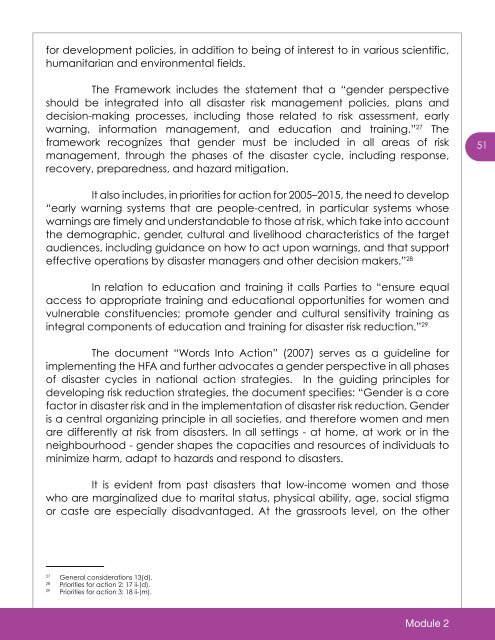GGCA Gender and Climate Change Training Manual - Women's ...
GGCA Gender and Climate Change Training Manual - Women's ...
GGCA Gender and Climate Change Training Manual - Women's ...
You also want an ePaper? Increase the reach of your titles
YUMPU automatically turns print PDFs into web optimized ePapers that Google loves.
for development policies, in addition to being of interest to in various scientific,<br />
humanitarian <strong>and</strong> environmental fields.<br />
The Framework includes the statement that a “gender perspective<br />
should be integrated into all disaster risk management policies, plans <strong>and</strong><br />
decision-making processes, including those related to risk assessment, early<br />
warning, information management, <strong>and</strong> education <strong>and</strong> training.” 27 The<br />
framework recognizes that gender must be included in all areas of risk<br />
management, through the phases of the disaster cycle, including response,<br />
recovery, preparedness, <strong>and</strong> hazard mitigation.<br />
51<br />
It also includes, in priorities for action for 2005–2015, the need to develop<br />
“early warning systems that are people-centred, in particular systems whose<br />
warnings are timely <strong>and</strong> underst<strong>and</strong>able to those at risk, which take into account<br />
the demographic, gender, cultural <strong>and</strong> livelihood characteristics of the target<br />
audiences, including guidance on how to act upon warnings, <strong>and</strong> that support<br />
effective operations by disaster managers <strong>and</strong> other decision makers.” 28<br />
In relation to education <strong>and</strong> training it calls Parties to “ensure equal<br />
access to appropriate training <strong>and</strong> educational opportunities for women <strong>and</strong><br />
vulnerable constituencies; promote gender <strong>and</strong> cultural sensitivity training as<br />
integral components of education <strong>and</strong> training for disaster risk reduction.” 29<br />
The document “Words Into Action” (2007) serves as a guideline for<br />
implementing the HFA <strong>and</strong> further advocates a gender perspective in all phases<br />
of disaster cycles in national action strategies. In the guiding principles for<br />
developing risk reduction strategies, the document specifies: “<strong>Gender</strong> is a core<br />
factor in disaster risk <strong>and</strong> in the implementation of disaster risk reduction. <strong>Gender</strong><br />
is a central organizing principle in all societies, <strong>and</strong> therefore women <strong>and</strong> men<br />
are differently at risk from disasters. In all settings - at home, at work or in the<br />
neighbourhood - gender shapes the capacities <strong>and</strong> resources of individuals to<br />
minimize harm, adapt to hazards <strong>and</strong> respond to disasters.<br />
It is evident from past disasters that low-income women <strong>and</strong> those<br />
who are marginalized due to marital status, physical ability, age, social stigma<br />
or caste are especially disadvantaged. At the grassroots level, on the other<br />
27<br />
General considerations 13(d).<br />
28<br />
Priorities for action 2: 17 ii-(d).<br />
29<br />
Priorities for action 3: 18 ii-(m).<br />
Module 2

















